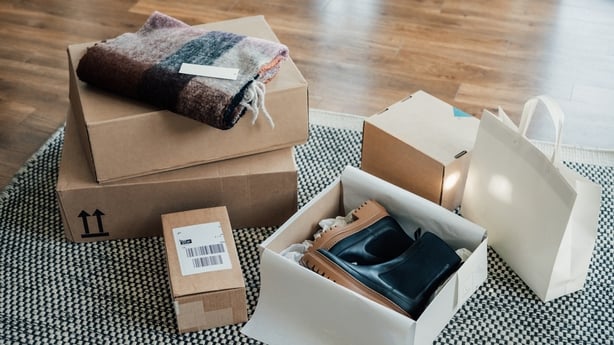Sarah Magliocco writes about the popularity of 'haul' videos, and how the push to build capsule or seasonal wardrobes can encourage unsustainable fast fashion habits.
'What to wear this autumn!' 'Update your wardrobe with these winter basics!' - these are just some of the cries we come across online and in shops once the season starts to turn.
Shopping at the beginning of a new season makes sense, but the proliferation of 'haul' videos where bloggers detail the often massive online orders they've made, is only adding to the frenzy.
The Haul Phenomenon
Haul videos have become part and parcel of online content, arguably starting with Blaire Fowler's MAC haul video in 2008 and exploding with the popularity of 10-minute YouTube videos, which was the staple length of a video on the platform for years.
Through them, we get to live vicariously and get the satisfying tingle of shopping without the cost of our own bank balances. The intention of these videos is usually to share chic finds with followers, but they do influence us to spend money by showcasing products we might not otherwise have even known we wanted.
Back-to-school clothing haul, new season style haul, cold-weather dressing haul, coats and jackets haul, Christmas party season haul, college everyday outfits haul, office dressing for the transitional weather haul - the list is truly endless.
Our social media feeds are increasingly littered with autumn and winter fashion hauls, with enormous plastic packages of clothing from fast fashion companies being poured out into piles of individually wrapped cellophane sheets of folded clothes.

The Capsule Wardrobe
There is nothing wrong with wanting to spice up your wardrobe for the new season, but our language around shopping seasonally, as well as our rate of consumption, has changed.
Where once a "capsule wardrobe" meant a somewhat blank canvas of interchangeable white t-shirts, black blazers and blue jeans, a concept hugely popular with the early millennial fondness for minimalism, it has been swapped out of the top spot for the seasonal wardrobe when it comes to popularity.
The phrases can also be used interchangeably on social media, blurring the lines when it comes to their meaning.
"As a stylist, I love the concept of capsule wardrobes - building your personal style whilst encouraging the re-wearing of clothing… What's not to love?" ponders stylist Becca Boyce, who has styled for publications like Kaltblut Magazine and Hunter Magazine.
"Unfortunately I can see how this definition has deviated in recent years, mostly due to the acceleration of the trend cycle on social media and in particular, TikTok."
"Now capsule wardrobes are encouraged to be created around whatever is in trend, which changes almost every day. Adding viral garments or the latest 'core' to your wardrobe is really the opposite of what the concept was designed to emulate. There is this need to wear the trendiest clothing, and of course, you must wear them before everyone else.
"I absolutely love when people are themselves and reflect this in their style - which can include trends - but wearing the latest style deemed cool as quickly as it has emerged, in my opinion, alleviates any originality."
#ShopTok
One of the most glaring differences between a traditional capsule wardrobe and a seasonal wardrobe is longevity, with capsule wardrobes focusing on pieces you can wear almost indefinitely while seasonal wardrobes can often include microtrend-based items from fast fashion companies - and a lot of them.
"There's a strong emphasis on consumerism on TikTok, especially with hauls," reflects Becca. "I think this has further skewed the definition of a capsule wardrobe to equal the more spent, the better the style. Through little fault of their own, this definitely turns consumers with lower budgets to fast fashion.
"If your capsule wardrobe, or any aspect of your style is made up of majority fast fashion pieces, it isn't going to last very long, both in fashion and physically. This of course works for the fast-paced nature of trends. These pieces conveniently fall apart as the next aesthetic comes around which really has brought us so far from the original creation of a capsule wardrobe."

Slow Fashion
Irish sustainable designer Sharon Sweeney, of the luxury slow fashion brand of the same name, explains that the constant creation and consumption of microtrends is leading to a devaluation of the idea of fashion and the clothes that we reach for each day.
"I think it devalues the meaning of what clothes should be to people. Online movements and micro-trends encourage people to not only consume mindlessly but also to copy trends instead of trying to develop one’s personal style," she explains.
"This leads to immense pressure among consumers and encourages impulse buying of clothing which is worn maybe a handful of times and inevitably dumped. Because it’s 'IN’ to never be seen in the same thing twice it means that people are drawn to fast fashion companies who provide the quick fix."
Becca echoes her feelings and points out that some microtrends we see are actually basic or classic fashion pieces that have been chic for decades, but when churned through the microtrend cycle, become dated in the space of a few weeks.
"I can see from the emergence and quick nature of microtrends that people have lost the value of clothes," Becca said. "Fashion is an art and should reflect the time and skill it takes to create beautiful pieces. I think when you have this appreciation for fashion you don’t even want to participate in microtrends because you love your clothes and style so much, for a substantial period at least - growth is vital."
For Sharon, reminding people to make purchases with intention is a key takeaway. The designer, based in Dublin, has recently launched a new collection titled Lucid Dreams, with each piece made-to-order here in Ireland. Fabrics used include Irish wool, tweed, organic cotton, and even recycled Jameson bottles - tangible, thoughtful materials that would not be featured in a fast fashion haul video.
"The consumer should really consider the piece they buy, how it will add to their life and will it be something they will use year after year," she mused. "I think that the focus should be on where it’s made, by whom it is made - the workers should be paid fairly and work in safe conditions. It should be made well and where possible with organic, sustainable fabrics."

Building a Wardrobe
Conscious consumption is almost a buzzword at this stage, a phrase we see churned up again and again to encourage the furthering of socially and environmentally friendly purchasing practices.
Becca’s styling tips to avoid the fast fashion cycle while building a wardrobe you truly love, can be proud of, and still feel trendy in are simple and reflect Shaon’s ethos of thinking before buying.
"Developing a capsule wardrobe absolutely does not mean you can never shop a trend again. After you come across a new style, try to spend time thinking about it, resisting the instant buy urge. Would you like it if you didn’t see your favourite influencer wear it? How many times will you wear it? Will you wear it if it stops being trendy? These are a few questions you should ask yourself when considering adding a piece to your wardrobe.
"I also always ensure I try to find the exact piece or similar second-hand. If you are not willing to go digging, online or in person for the garment, you may not be fully committed. I spent six months searching for the shoes I am wearing right now, on the basis of hard work alone, I don’t see myself regretting that purchase."

Next Steps
Haul videos, seasonal or otherwise, have stuck around longer than any of the fashion trends they have ever catapulted to fame, and it doesn’t look like they are going anywhere anytime soon, but our reactions to them as consumers can change.
"The trend cycle and the fast fashion industry is causing unimaginable damage to the environment and not one that I want to be a part of. In my opinion, the most fashionable thing you can do is be yourself and consume consciously," says Becca.
While there is no shame in enjoying the enticement of an influencer waving bursting shopping bags at you from your screen, consciously distancing yourself from the immediate impulse to copy their consumption is the first step on the road to never standing front of a full wardrobe and feeling like you have nothing to wear again.


